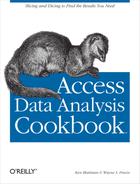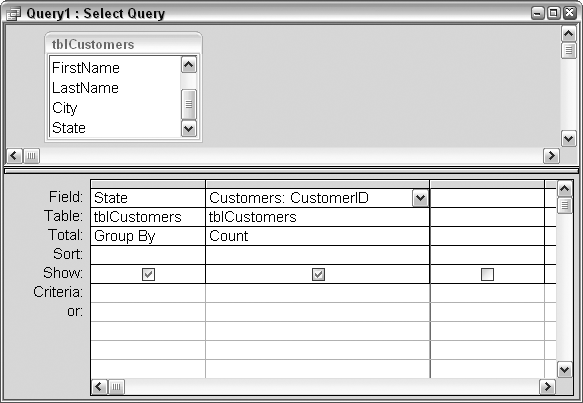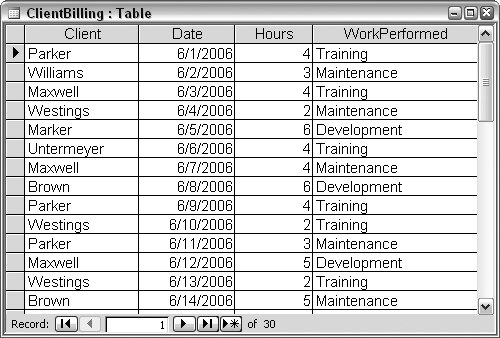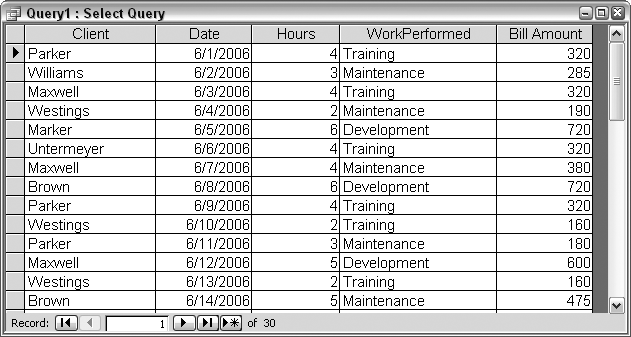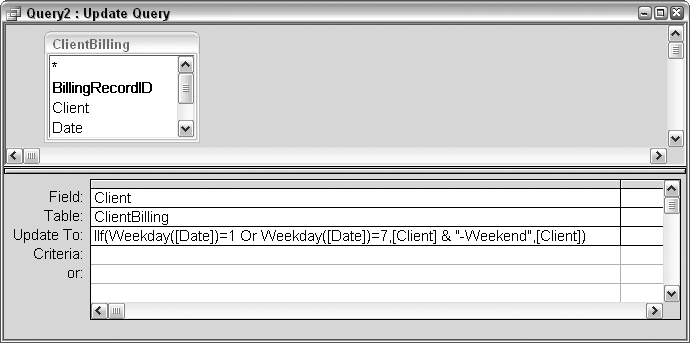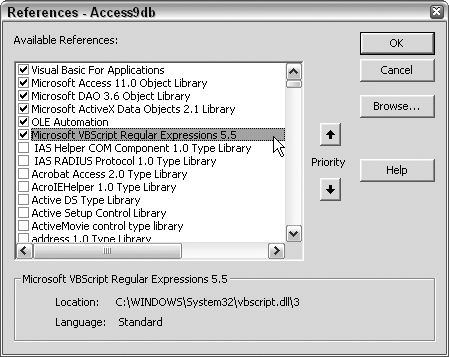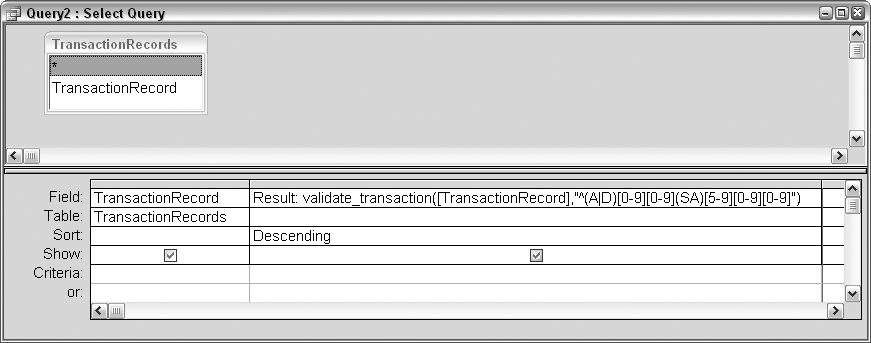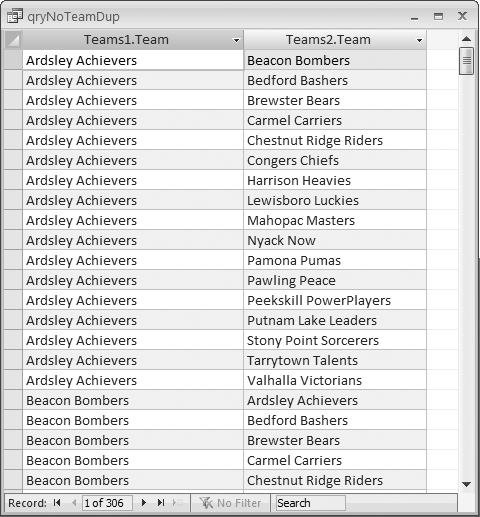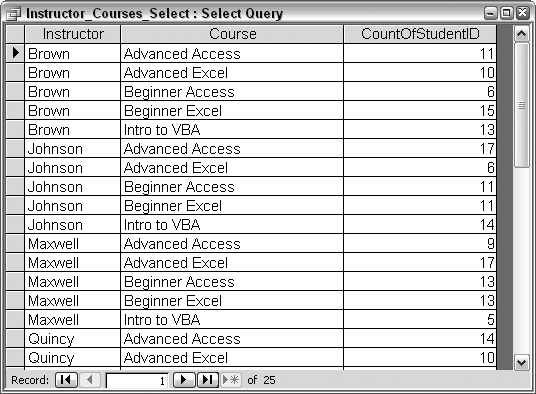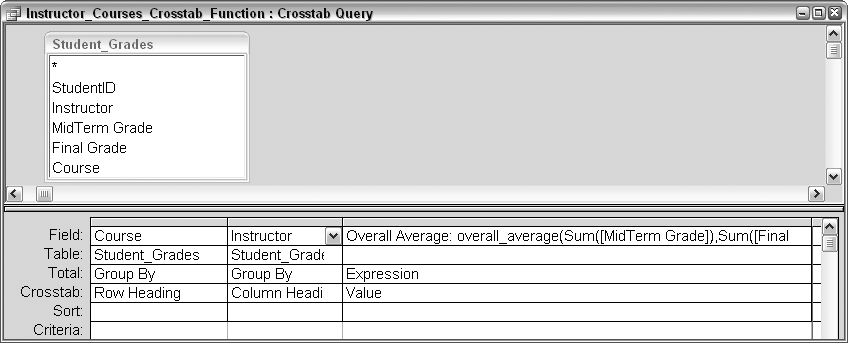Chapter 2. Calculating with Queries
Queries can tell you a lot about your data. In addition to simply returning records, you can use aggregate functions that are part of the SQL language to return summaries of your data. There are aggregate functions that can sum, average, count, find the highest or lowest value, or return the standard deviation in the data, just to name a few. Not all are covered in the recipes in this chapter, but once you have a general idea of how aggregate functions work, you should be able to use any of them.
In this chapter, you’ll also find recipes that showcase how to use your own custom, non-SQL functions from within a query. This is a very powerful technique because it enables you to design functions that deliver values that meet your exact requirements. And that’s not all! There is also a recipe that describes how to use regular expressions, which provide powerful pattern-matching abilities, as well as recipes that demonstrate how to return all possible combinations of your data using a Cartesian product and how to construct crosstab queries.
Finding the Sum or Average in a Set of Data
Problem
Sometimes I need to summarize numerical data in a table. I know how to do this in a report—by using a calculation in a text box, in the report’s footer. But how can I get a sum or average without having to create a report (or pull out a calculator)?
Solution
SQL provides aggregate functions that provide summaries of data. Two popular aggregate functions are Sum and Avg (for calculating the average). You can easily incorporate these into your query’s design right within the query grid.
To use an aggregate function, select the View →Totals menu option while in the query grid (or, in Access 2007, click the Sigma (Σ) button in the Ribbon). This makes the Total row display in the grid. The Total row provides the assorted aggregate functions in a drop-down list.
Say you have a tblSales table containing a Customer_ID field, a PurchaseDate field, and an Amount field. There are records spanning dates from 2002 through 2005. To get a fast grand total of all the amounts in the table, just apply the Sum function to the Amount field. Figure 2-1 shows the design of the query, with the Sum function selected from the drop-down list in the Total row for the Amount field.
shows the result of running the query.
Note that a derived field name, SumOfAmount, has been used in the result. If you want, you can change this name in the SQL or by using an expression in the Field row of the query grid. Figure 2-3 shows how you can change the returned field name to Grand Total by using that name in the Field row, along with a colon (:) and the real field name.
To return an average of the values, use the same approach, but instead of Sum, select Avg from the drop-down list in the Total row.
Discussion
Aggregate functions are flexible. You can apply criteria to limit the number of records to which the aggregation is applied—for example, you can calculate the average amount from purchases in just 2005. Figure 2-4 shows how to design a query to do so. Note that the criterion to limit the Amount field is placed in the second column, not in the same column that contains the Avg function. Also, the Show box is unchecked in the column with the criterion, so only the average in the first column is displayed when the query is run.
Figure 2-5 shows another example: a query design to calculate an average amount from amounts that are greater than or equal to 200. The average returned by this query will be higher than that returned by a query based on all the records.
The SQL generated from this design is:
SELECT Avg(tblSales.Amount) AS AvgOfAmount FROM tblSales WHERE (((tblSales.Amount)>=200));
Finding the Number of Items per Group
Problem
I have a table of data containing customer address information. One of the fields is State. How do I create a query to return the number of customers in each state?
Solution
When a query uses aggregate functions, the Group By clause is a keystone. This SQL clause provides a grouping segregation, which then allows aggregation summaries to be applied per grouping. In this example, the Group By clause is applied to the State field. Then, the Count aggregate function is used to return the count of customers per group (i.e., per state).
Figure 2-6 shows the design of the query. The first column groups the State field. In the second column, the Count function is selected from the drop-down list in the Total row.
Figure 2-7 shows the result of running the query. The number of customers in each state is returned.
Discussion
The Group By clause can be applied to more than one field. In such a case, in sequence, each field that uses Group By further defines the narrowness of the count at the end.
Let’s refine our count so we can see how many customers are in each city within each state. Figure 2-8 shows the breakdown of customers in Alaska by city. In the query result shown in Figure 2-7, Alaska has a count of 20 customers. In the query result shown in Figure 2-8, there are still 20 customers listed in Alaska, but now you can see the counts per city.
The SQL statement for the query in Figure 2-8 is this:
SELECT tblCustomers.State, tblCustomers.City, Count(tblCustomers.CustomerID) AS Customers FROM tblCustomers GROUP BY tblCustomers.State, tblCustomers.City;
Using Expressions in Queries
Problem
I know how to create on-the-fly fields in a query (see Inserting On-the-Fly Fields in Select Queries), and how to include some conditional intelligence. How, though, do I access a value that is not in an underlying table or query, but instead comes from another table altogether? How can I develop comprehensive expressions in a query?
Solution
Expressions are a powerful feature in Access. Expressions are used in a number of ways, such as for referencing forms and controls (whether from a macro, from a query, or from VBA). For this example, we’ll use an expression within a query that accesses data from tables not included in the query’s Select statement.
Figure 2-9 shows a query based on two tables: tblClients and tblPets. The key between these tables is ClientID. A field called PetID is the unique key for pets in the tblPets table. Two external tables, tblServiceDates and tblServiceDates_New, contain records of visits made by each pet. The first service date table, tblServiceDates, contains records for pets with PetIDs of up to 299. Higher PetIDs have service date records in the tblServiceDates_New table.
In the query in Figure 2-9 is a field based on a built-up expression, shown here:
Last Service Date: IIf([PetID]<300,
DLookUp("Max(DateOfService)",
"tblServiceDates","[Pet_ID]=" & [PetID]),
DLookUp("Max(DateOfService)",
"tblServiceDates_New",
"[Pet_ID]=" & [PetID]))This expression combines functions (IIf, DLookup, and Max) to find the last service date for each pet from the respective service date tables.
The full SQL statement that is generated from this design is:
SELECT tblPets.PetID, tblClients.ClientLastName,
tblPets.PetType, IIf([PetID]<300,
DLookUp("Max(DateOfService)",
"tblServiceDates","[Pet_ID]=" & [PetID]),
DLookUp("Max(DateOfService)","tblServiceDates_New",
"[Pet_ID]=" & [PetID])) AS [Last Service Date]
FROM tblClients INNER JOIN tblPets ON
tblClients.ClientID = tblPets.ClientID;In summary, within a query, it is possible to build up a sophisticated expression that uses functions to address data and calculate results that stand outside of the standard SQL syntax.
Discussion
Entering complex expressions into a single row in the query grid can be difficult, given the limited width of a computer monitor. One workaround is to use the Zoom box, as demonstrated in Figure 2-9. To display the Zoom box, right-click on the query grid where you want the entry to go, and select Zoom from the pop-up menu. Pressing Shift-F2 also displays the Zoom box.
Another choice on the pop-up menu is Build. Selecting this displays the Expression Builder dialog box, seen in Figure 2-10. This utility makes it easy to assemble complex expressions, as it makes all the database objects, functions, and more available for you to use with just a few mouse clicks.
Using Custom Functions in Queries
Problem
I often write long code routines to read through a table and process its data. It would be great if I could reduce the amount of code required by not creating and reading through a recordset. A select query addresses the table just as well. Is there a way to just apply the processing portion of the code direct from a query?
Solution
Calling a function from a query is relatively easy. Just use an extra column in the query grid to create a derived field. In that field, place an expression that calls the function; the returned value from the function is what will appear in the query result.
Figure 2-11 shows a table with records of activities performed for different clients. The records list the client name, the date when the work was done, the number of hours it took, and the type of work that was performed. The task is to calculate how much to charge for the work, per record.
First, let’s develop a function that we can call from a query. It’s important that this is a function and not just a sub. We need a returned value to appear in the query results, and while functions return values, subs do not. Here is the bill_amount function:
Function bill_amount(the_date As Date, the_hours As Integer, _ the_client As String, WorkType As String) As Single bill_amount = 0 'in case of unexpected input Select Case WorkType
Case "Training" bill_amount = the_hours * 80 Case "Development" bill_amount = the_hours * 120 Case "Maintenance" 'Parker gets reduced rate regardless of day of week 'Other clients have separate weekday and weekend rates If the_client <> "Parker" Then If Weekday(the_date) = 1 Or Weekday(the_date = 7) Then bill_amount = the_hours * 95 Else bill_amount = the_hours * 75 End If Else bill_amount = the_hours * 60 End If End Select End Function
The function takes four arguments—one each for the four fields in the table—and calculates the amount to bill based on different facets of the data. The type of work performed, the client for whom it was performed, and whether it was done on the weekend (determined with the Weekday function) all determine which hourly rate to use. The hourly rate and the number of hours are then multiplied to determine the billing amount.
Figure 2-12 shows the query design. Note that you don’t have to place the table fields in the grid unless you want them to appear with the values returned from the function.
The function is called in the query in a separate column. The structure of the expression is:
Bill Amount: bill_amount([Date],[Hours],[Client],[WorkPerformed])
Bill Amount is the name of the temporary field. bill_amount is the name of the function, and the four fields are included as arguments. The fields are each encased in brackets, consistent with the standard Access field-handling protocol.
When the query is run, the fifth column contains the billable amount, as shown in Figure 2-13.
Discussion
Calling functions from queries opens up many ways of working with your data. The function used in this example is short and processes an easy calculation. But do note that this function actually calls another function, Weekday. The point is that you can develop sophisticated functions that perform all types of processing.
Both custom functions and built-in functions can be called from a query. Further, the query does not have to be a select query; you can call functions from action queries (discussed in Chapter 3) as well. Figure 2-14 shows an example of using two built-in functions, IIf and Weekday, to update the value in a field. If the date falls on the weekend, -Weekend is appended to the client name.
Take a closer look at the expression used in the Update To row:
IIf(Weekday([Date])=1 Or Weekday([Date])=7,[Client] & "-Weekend",[Client])
If the weekday is a 1 or a 7 (a Sunday or a Saturday), -Weekend is appended to the client name; otherwise, the client name is used for the update as is. In other words, every row is updated, but most rows are updated to the existing value.
Using Regular Expressions in Queries
Problem
Regular expressions provide the ability to set up sophisticated string patterns for matching records. Can a regular expression be used as the criterion in a query?
Solution
Regular expressions, popularized by Perl and other Unix-based languages, provide powerful string-matching capabilities. For Access and other Windows-based applications, adding a reference to the VBScript Regular Expressions library makes using regular expressions possible. You can set up the reference in the Visual Basic Editor (VBE). To display the VBE from Access, just press Alt-F11. While in the VBE, use the Tools →References menu option to display the References dialog. Then set a reference to Microsoft VBScript Regular Expressions 5.5 (your version number may be different), as shown in Figure 2-15.
Figure 2-16 shows a table with hypothetical transaction records.
The values in the TransactionRecord field are concatenations of separate codes and values that follow this pattern:
The first character is a letter that signifies a type of transaction. For example, an A could mean an adjustment, and a D could mean a deposit.
The next two characters are numbers that represent a transaction type.
The next two characters are a department code. For example, LE is Legal, SA is Sales, HR is Human Resources, WA is Warehouse, and so on.
The last three numbers are an amount.
Given this pattern, let’s construct a query that will identify transactions that are either adjustments or deposits, are for the Sales department, and are for amounts of 500 or greater. Put another way, our task will be to identify transaction records consisting of an A or a D, followed by any two numbers, followed by SA, followed by a number that is 5 or greater, and any two other numbers.
To make use of pattern matching, we’ll use a custom function to create a regular expression (regexp) object. In a separate code module, enter this function:
Function validate_transaction(transaction_record As String, _ match_string As String) As String validate_transaction = "Invalid Record" Dim regexp As regexp Set regexp = New regexp With regexp .Global = True .IgnoreCase = True .Pattern = match_string If .Test(transaction_record) = True Then validate_transaction = "Valid Record" End If End With Set regexp = Nothing End Function
The transaction record and the regular expression pattern to match are given to the function as arguments. The function code initially sets the return value to Invalid Record. A regexp object is set, and the transaction record is tested against the pattern. If the transaction record matches the pattern, the return value is changed to Valid Record.
Now, we’ll call this function from a query. Figure 2-17 shows a select query that places the call to the function in the second column. Note that the column with the function to call is set to a descending sort. This is so all valid records will appear at the top. Unlike a typical select query that returns just the records that match the criteria, in this case all records are returned, so it makes sense to group together all the valid records.
Figure 2-18 shows the result of running the query. The valid records are at the top.
Discussion
The pattern used for matching the transaction records look like this:
^(A|D)[0-9][0-9](SA)[5-9][0-9][0-9]
A detailed explanation of regular expression syntax is beyond the scope of this recipe, but in a nutshell, here is what the pattern calls for:
(A|D) indicates to match an A or a D.
[0-9] indicates to match any single numerical digit between 0 and 9 (effectively, any number).
(SA) indicates to match SA.
[5-9] indicates to match any numerical digit between 5 and 9. Since this is followed in the pattern by two more occurrences of [0-9] (i.e., any number), taken together, a value of 500 or greater is sought.
Test is just one method of the regexp object. There also are Execute and Replace methods. Execute creates a collection of matches. This is useful in code-centric applications, where further processing would take place in a routine. The Replace method replaces a match with a new string. Figure 2-18. Records are validated using a regular expression
Using a Cartesian Product to Return All Combinations of Data
Problem
I have a list of teams and a list of locations with ballparks. I wish to create a master list of all the combinations possible between these two lists.
Solution
We typically use queries to limit the amount of returned records, and at the very least, we expect the number of returned records to be no greater than the number of records in the largest table or query being addressed.
However, there is a special type of join, called a Cartesian join, that returns the multiplicative result of the fields in the query (otherwise known as the Cartesian product). A Cartesian join is the antithesis of standard joins—it works as if there is no join. Whereas the other join types link tables together on common fields, no field linking is required to return a Cartesian product.
Figure 2-19 shows a table of teams and a table of locations. Simply put, we are looking for all the combinations that can exist between these two tables.
Figure 2-20 shows the design of a query that essentially has no join. There is no line connecting the tables. In fact, the single fields in each table really don’t relate to each other.
The SQL generated by the design in Figure 2-20 looks like this:
SELECT Teams1.Team, Locations.Location FROM Teams1, Locations;
Note that even in the SQL, no join is stated.
When the query is run, all possible combinations are returned. The Teams1 table has 18 records, and the Locations table has 10 records. Figure 2-21 shows the query result, which returns 180 records.
Discussion
What if, for example, you needed a master list of all possible team versus team combinations? This task is a little different, as it involves creating a Cartesian product of a single field. If you design a query with one table and just pull the field into two columns, you will not gain any new records or combinations. You need a duplicate teams table to make this work.
Copy the Teams1 table and name the copy Teams2. You now have two tables that are identical, apart from their names. When making a Cartesian query that’s based on two identical fields, your aim will typically be to get all possible combinations except for an entity combined with itself. For example, there is no point in matching a team with itself—the Carmel Carriers will never play against the Carmel Carriers!
Figure 2-22 shows a design that will return all possible match combinations, except those where the teams are the same. The SQL statement for this query is:
SELECT Teams1.Team, Teams2.Team FROM Teams1, Teams2 WHERE (((Teams1.Team)<>[Teams2].[Team])) GROUP BY Teams1.Team, Teams2.Team;
Figure 2-23 shows the result of running the query. Notice that there is no record in which the Ardsley Achievers appear in both columns—this type of duplication has been avoided. To confirm this, you can check the number of returned records. There are 18 teams, and 18 multiplied by 18 is 324, yet only 306 records were returned. The 18 records that would have shown the same team name in both columns did not make it into the result.
Creating a Crosstab Query to View Complex Information
Problem
How can I view my relational data in a hierarchical manner? I know I can use Group By clauses in a query, but with an abundance of data points, this becomes cumber-some and creates many records. Is there another way to see summaries of data based on groupings?
Solution
A crosstab query is a great alternative to a standard select that groups on a number of fields. Figure 2-24 shows the Student_Grades table, which has five fields: StudentID, Instructor, MidTerm Grade, Final Grade, and Course.
Using the information in the Student_Grades table, it is possible to get a per-instructor count of how many students attended each course. Figure 2-25 shows the design of a standard select query that accomplishes this. The Group By clauses create delineations of Instructor and Course, and within each combination, a Count of the StudentID field returns the count of students. The SQL for this query is:
SELECT Student_Grades.Instructor, Student_Grades.Course, Count(Student_Grades.StudentID) AS CountOfStudentID FROM Student_Grades GROUP BY Student_Grades.Instructor, Student_Grades.Course;
Running the query in Figure 2-25 produces a result with 25 records, shown in Figure 2-26.
Now for the alternative. A crosstab query will return the same student counts, per instructor, per course; however, the layout will be smaller. The design of the crosstab query is shown in Figure 2-27. Crosstabs require a minimum of one Row Heading field, one Column Heading field, and one Value field in which the reporting is done.
In this case, the Value field is the StudentID field, and Count is the selected aggregate function (as it was in the equivalent select query). The Instructor field is designated as a Row Heading, and the Course field is designated as the Column Heading.
The SQL behind the crosstab query reads like this:
TRANSFORM Count(Student_Grades.StudentID) AS CountOfStudentID SELECT Student_Grades.Instructor FROM Student_Grades GROUP BY Student_Grades.Instructor PIVOT Student_Grades.Course;
Note the TRANSFORM and PIVOT statements. These are unique to creating a crosstab and are explained in the Discussion section. Figure 2-28 shows the result of running the query. Just five rows are returned—one for each instructor—and there is a column for each course.
Discussion
To recap, a crosstab query requires:
One or more Row Heading fields
One Column Heading field
One Value field
To create a crosstab query, select the Query →Crosstab Query menu option while in the query designer. This will cause the Crosstab row to display in the query grid. Alternatively, you can use the Crosstab Query Wizard. To launch the wizard, click the New button while the Queries tab is on top in the database window. Then, select Crosstab Query Wizard in the New Query dialog box.
In the SQL syntax, a TRANSFORM statement is what designates the query as a crosstab. Following directly after the TRANSFORM keyword are the aggregate function and the Value field to be used. The one or more fields following the SELECT statement are the Row Headings. The field following the PIVOT keyword is the field from which the column headings will be drawn.
The previous query produced results in which the row headings were the instructor names and the column headings were the course names (Figure 2-28). Swapping the fields in the SELECT and PIVOT sections reverses the structure of the output. In other words, using this SQL:
TRANSFORM Count(Student_Grades.StudentID) AS CountOfStudentID SELECT Student_Grades.Course FROM Student_Grades GROUP BY Student_Grades.Course PIVOT Student_Grades.Instructor;
creates the output shown in Figure 2-29. Now, the courses are listed as rows and the column headings are the instructor names. Regardless of the layout, the counts are consistent.
Sophisticated crosstabs
In the examples we’ve looked at so far in this recipe, after the TRANSFORM keyword, we’ve applied an aggregate function to a single field. A limitation of crosstab queries is that only one Value field can be evaluated; attempting to include a second aggregation would result in an error. But what if you need to process information from more than one field?
While only one value can be returned for each row and column intersection, there are options for how that value is calculated. Let’s say we need to find the overall average for each course—that is, the combined average of the MidTerm Grade and Final Grade fields. This will provide an overall average per course, per instructor. The catch here is that two fields contain values that need to be considered: MidTerm Grade and Final Grade.
To accomplish this task, we’ll place a function call where the Value field is usually specified, and we’ll select Expression in the Total row. Figure 2-30 shows the query design.
The full expression reads like this:
Overall Average: overall_average(Sum([MidTerm Grade]), Sum([Final Grade]),Count([StudentID]))
The SQL statement looks like this:
TRANSFORMoverall_average(Sum([MidTerm Grade]), Sum([Final Grade]),Count([StudentID])) AS [Overall Average] SELECT Student_Grades.Course FROM Student_Grades GROUP BY Student_Grades.Course PIVOT Student_Grades.Instructor;
As the query runs, the overall_average function is called. The arguments it receives are the midterm grade, the final grade, and the count of students. Bear in mind that, one at a time, these three arguments are providing information based on a combination of instructor and course.
The overall_average function calculates the overall average by adding together the sum of each grade type (which creates a total grade), and then dividing the total by twice the student count—each student has two grades in the total, so to get the correct average, the divisor must be twice the student count. Here is the function:
Function overall_average(midterm_sum As Long, _ final_sum As Long, student_count As Integer) As Single overall_average = (midterm_sum + final_sum) / (student_count * 2) End Function
Figure 2-31 shows the result of running this crosstab. The returned values are the overall averages of the combined grades.
The returned values in Figure 2-31 are drawn out to several decimal places. Using the Round function helps pare them down. Here is the updated function, with the rounded values shown in Figure 2-32:
Function overall_average(midterm_sum As Long, _ final_sum As Long, student_count As Integer) As Single overall_average = Round((midterm_sum + final_sum) / (student_count * 2)) End Function
While you can only display a single value in the result, you have many options for calculating that value. The approach presented here—using a function to calculate a value it’s not possible to determine with the singular aggregate functions—is a useful and flexible one.
